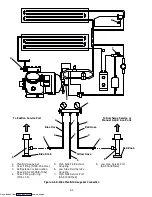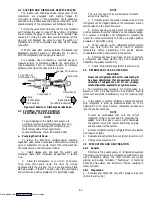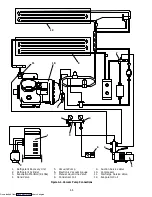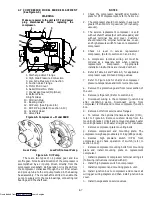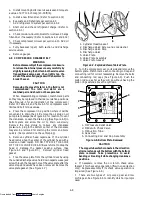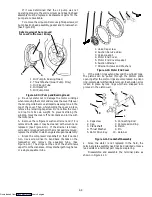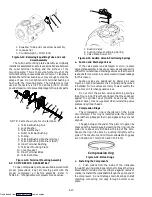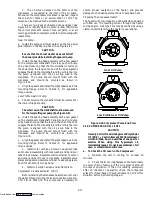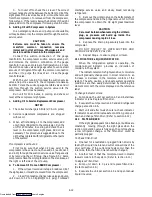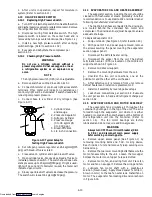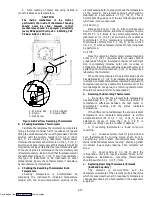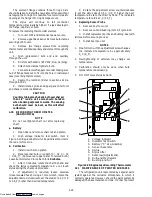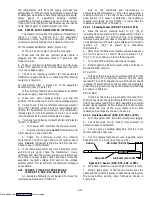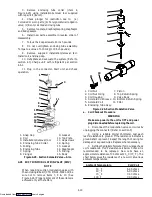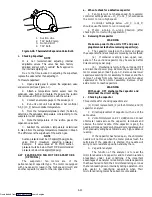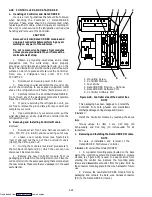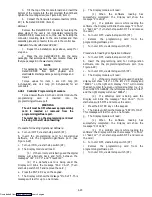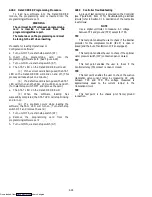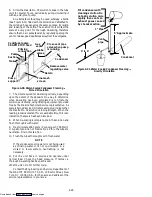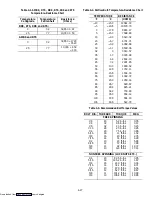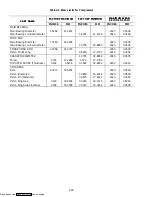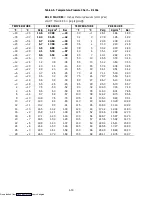
4-16
The element flange contains three O-rings. Care
should be taken to install the new element flange without
damaging the O-rings. It is possible for a mercury leak to
develop at the flange if O-ring damage occurs.
The stylus will continue to fall (container
temperature will actually be higher) if a leak develops in
the flange, capillary or bulb.
To replace the recording thermometer element:
1. Turn unit OFF and disconnect power source.
2. Remove upper back panel. Remove bulb clamps
securing bulb to unit.
3. Remove two flange screws from recording
thermometer and feed capillary and element through the
unit.
4. Push replacement bulb end and capillary
through the unit.
5. Fill slots with silastic (RTV432, Dow Corning).
6. Attach bulb clamps tightly to bulb.
7. Connect element flange to recorder making sure
hub of flange faces out to fit into the hole in instrument
case (recording thermometer).
8. Rezero the recorder. (Refer to sections 4.19.a.
through 4.19.d.)
9. Install inlet air grille and upper panel. Start unit
and check recorder calibration.
CAUTION
Capillary tubing may be bent, but never sharper
than 1/2” radius: extra care should be taken
when bending adjacent to welds. The sensing
bulb should never be bent, as this will affect
calibration.
4.20 RECORDING THERMOMETER
(SAGINOMIYA)
NOTE
Do not overtighten chart nut after replacing
chart.
a. Battery
1. Open door and remove chart nut and platen.
2. Push voltage indicator test switch, item 2,
Figure 4-20. Replace battery if voltage indicator points to
the red or white zone.
b. Calibration
1. Install new chart on platen.
2. Place recorder bulb in ice bath (0
¦
0.2
_
C = 32
¦
0.35
_
F). (Remove rear upper panel to remove bulb.)
Leave bulb immersed in ice bath for
10 minutes.
3. After 10 minutes, rotate the chart by hand and
check the stylus indicated temperature. Do not touch
stylus during the checkout procedure.
4. If adjustment is required, loosen setscrew
(cross-recessed head). Using a 7 mm wrench, rotate the
adjustment screw clockwise to set the stylus 1 to 2
_
C (1.8
to 3.6
_
F) higher than desired temperature.
5. Rotate the adjustment screw counterclockwise
to set the stylus about 0.5
_
C (0.9
_
F) higher than set
temperature. Rotate the chart by hand. The indicated
temperature should be 0
_
C (32
_
F).
c. Replacing Sensor Probe
1. Remove box from unit.
2. Remove nut and bushing, item 9, Figure 4-20.
3. Install replacement probe and bushing. Seal with
silicone before securing to case.
4. Install box into unit.
NOTES
1. One full turn with the adjustment screw changes
the indicated temperature by approximately
5
_
C (9
_
F).
2. Overtightening of setscrew may change set
temperature.
3. Calibration should only be done when bulb
temperature is decreasing.
4. DO NOT move stylus by hand.
1. Voltage Indicator
2. Indicator Test Switch
3. Battery (“C” size, Alkaline)
4. Sensor Assembly
5. Stylus
6. Stylus Lifter
7. Setscrew (Adjustment)
8. Bulb and Mechanism
9. Bushing and Nut
1
2
3
4
9
5
6
7
8
Figure 4-20. Saginomiya Recording Thermometer
4.21 MAINTENANCE OF PAINTED SURFACES
The refrigeration unit is protected by a special paint
system against the corrosive atmosphere in which it
normally operates. However, should the paint system be
damaged, the base metal can corrode. In order to protect
Downloaded from

